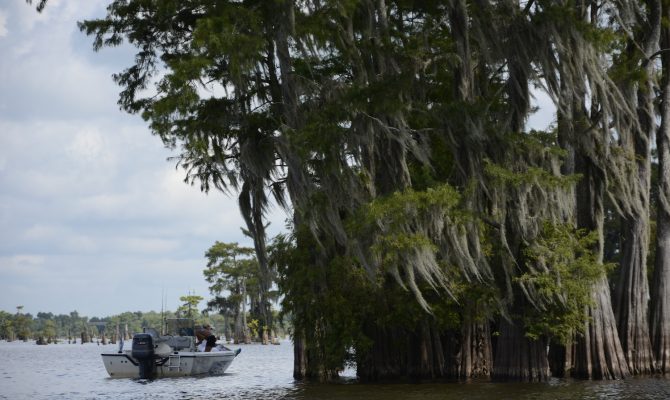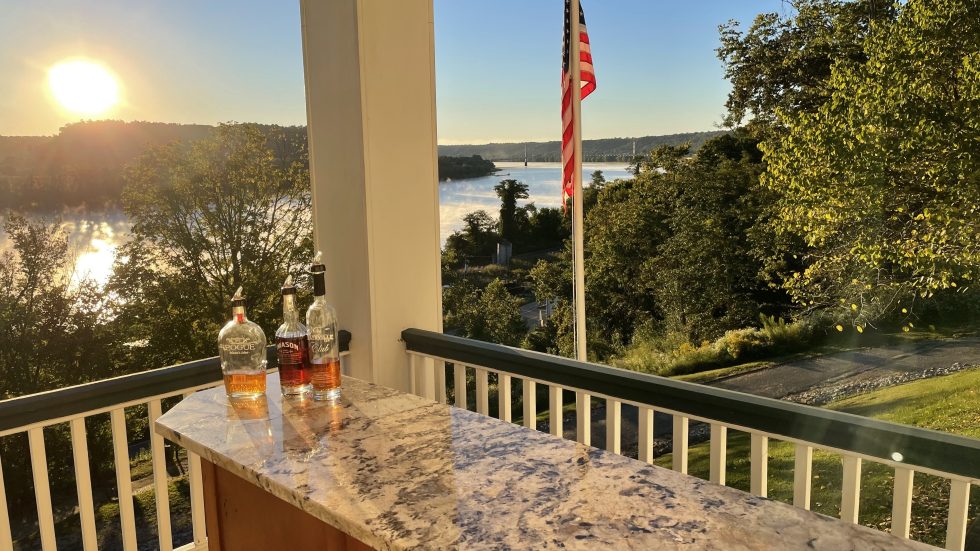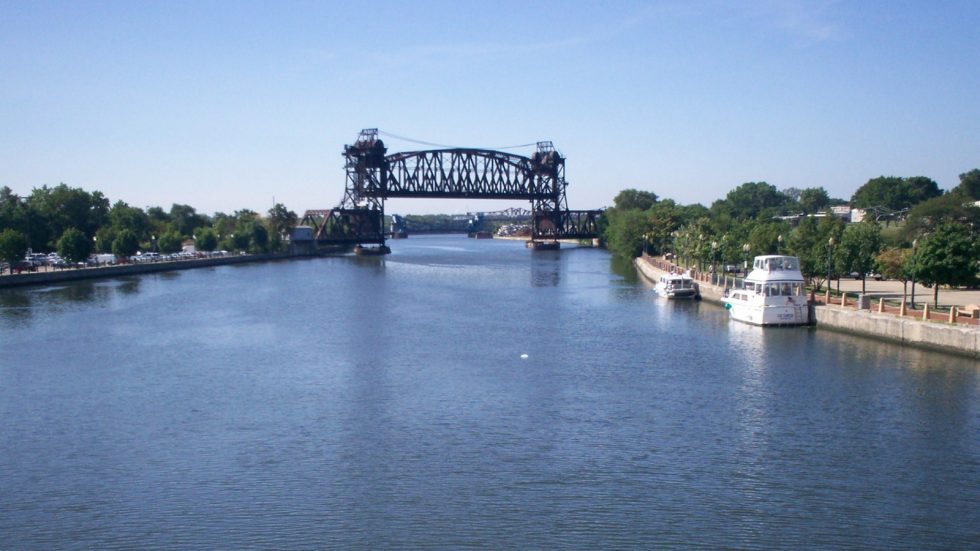The Atchafalaya River Basin is one of the largest unspoiled wetland regions in the U.S. Stands of cypress trees, branches thickly hung with Spanish moss and roots curling like the gnarled arms of a dozen trolls digging for treasure, are sprinkled throughout the basin. Perhaps the most iconic image of the Deep South and Cajun culture, they’re just one of the many reasons Louisiana makes the top of my list of favorite boating states.
Atchafalaya Basin
The Atchafalaya Basin’s story begins with its name, which means “long river,” from the Choctaw term “hacha falaia.” It’s the largest river swamp in the U.S. at nearly a million acres, filled with bottomland hardwoods, swamps, marshes and backwater lakes. In the mid-16th century, French colonists exiled from Canada joined the Native American inhabitants here, and the Cajun culture of today grew over the next few hundred years.
My visit to the Atchafalaya Basin kicked off with a Zydeco breakfast at the Café Des Amis in historic Breaux Bridge. I’d been advised to arrive early — and I did, at 7:30 a.m. — only to find there was already a line waiting for the door to open at 8:00. Once I was seated and the trio of Zydeco musicians started to play, I understood the attraction.
Zydeco starts with the accordion, something I grew up with back on the Saskatchewan prairies, listening to my Hungarian uncles. But this was altogether a different experience, as the music grew out of the tradition of southern Louisiana’s multilayered Creole culture.
I watched with fascination as the dance floor of the diner filled with energetic patrons. Leon, one of the locals who never sat out a tune, told me he was just a month short of 59 years old. While it was hard not to focus on Leon and his steady stream of dance partners, I did eventually eat some delicious sweet potato pancakes with fresh strawberries. Had it been later in the day, I’d have tried the famous crawfish pie.
Breaux Bridge, in fact, is commonly known as “the crawfish capital of world,” a traditional Louisiana specialty that looks, tastes and smells like seafood but doesn’t come from the sea. Instead, crawfish (or crayfish) live in the mud of freshwater bayous like those of the Atchafalaya Basin — thus their nickname, “mud bugs.” It’s estimated that 22 million pounds of crawfish are harvested here annually.
Meeting Capt. Curtis
McGee’s Landing is located on the Henderson Levee Road, just outside the small town of Henderson, 18 miles from Lafayette. Here, I found everything that keeps me coming back to Louisiana year after year.
You can dock your boat, rent a cabin or camp for the night; sample some Cajun staples such as alligator, crawfish etoufee, seafood gumbo and boiled crabs at the Café and Bar; and listen to authentic live music. From the dining room you get a view of Henderson Lake, then you can hop over to the other side of the levee to see Bayou Amy at the campground.
Of course the Swamp Tour with Captain Curtis, who declared he was “as old as the oldest gator,” was the high point of our visit to McGee’s. We boarded the covered pontoon boat, intent of discovering the secrets of the swamp. The alligators, however, kept out of sight for the greater part that morning, so we only saw a couple on the tiny cypress-covered islands.
Captain Curtis, his wizened face split in a constant grin, entertained us with his tales of local life. As he joked, “Best part of living on water is, if you don’t like your neighbor, you go at night and cut his rope…and he’s gone!” But then, he added with another laugh, “A stranger is only a friend you haven’t met yet.”
A lot of the captain’s stories focused on the history of the area, as he explained how logging a century and a half ago had forever changed the basin. Cypress trees thousands of years old that grew to 150 feet high were harvested for their lumber. Now, after canals were cut to log the area, the cypress that remain are still young by comparison, their growth far short of the size of the original forests. It is, though, the largest remaining contiguous tract of coastal cypress in the U.S.
We took a leisurely pace across the water, passing small fishing boats looking for bass, white perch, crappie and bream; watching egrets hunt for lunch; and finally gliding under the massive pillars of the Atchafalaya Basin Bridge. Also known as the Louisiana Airborne Memorial Bridge, the span, at 18.2 miles in length, is the second longest when measured shore-to-shore — surpassed only by Louisiana’s Lake Pontchartrain Causeway.
Our return trip was faster but still a lot of fun. Knowing I was Canadian, Captain Curtis teased me, saying, “Saw Bigfoot here last year. He was shavin’ his head. Bet he’s shavin’ again this month in the heat.”
Like Bigfoot, I needed something cooler, so it was on to the town of Henderson.
Dr. Who & Dinosaurs
Henderson has population just under 2,000, but it offers a range of services and attractions. I was fascinated with its Louisiana Marketshops at the 115, a seemingly endless number of stores under a single roof, with everything from hand-painted Acadian fiddles to metal yard birds and T-shirts. The place unfolded like Dr. Who’s Tardis, the time-traveling phone booth that seems endless. In fact, I spent so much time exploring that I had to cross a visit the 12-acre Prehistoric Park, the only Louisiana attraction dedicated to dinosaurs, off my itinerary.
If there’s one thing I enjoy even more than a marketplace, though, it’s food. So, I chose Crawfish Town USA, situated in an early 1900’s red barn, for dinner. With its full Cajun menu featuring tasty boudin balls, alligator, frog legs, fried oysters, catfish and, of course, crawfish, there’s a taste for everyone. Me, I chose the seafood jambalaya along with crab cake Atchafalaya. Yum, what a way to end a perfect day in Atchafalaya Basin’s Cajun country!
Author: Linda Aksomitis is a contributor to HeartLand Boating
IF YOU GO
Attractions:
Atchafalaya National Heritage Area, www.atchafalaya.org
Louisiana Marketshops at the 115, www.louisianamarketshops.wordpress.com
Prehistoric Park, www.prehistoric-park.com
Marinas/Dockage:
Atchafalaya Basin Landing & Marina, www.basinlanding.com
McGee’s Landing, www.mcgeeslanding.com
Restaurants:
Crawfish Town USA, www.crawfishtownusa.com
Café Des Amis, www.cafedesamis.com




